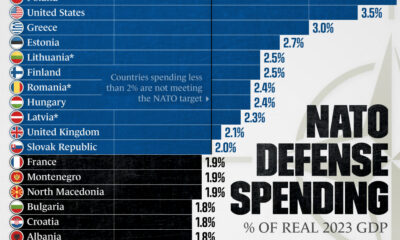Technology
The Future of Military Technology is Intense
Railguns sound like they’re straight out of a Schwarzenegger action movie.
Well, they are – but the reality is that railguns, along with other high-tech weapons such as lasers or hypersonic weapons, are already here.
The U.S. military has actually been testing lasers and railguns for some time, and has now started to mount 30-kW infrared solid-state laser systems on aircraft and gunships. Lockheed has also signed a $147 million contract to build hypersonic weapons that will fire at Mach 20, intercepting targets in under an hour using pure kinetic force.
Visualizing the Future of Military Technology
Today’s infographic comes from Futurism, showing the technological advancements we can expect to materialize in the battlefield over the coming decades.

The future of military technology is here, and it seems to borrow ideas right out of well-known movies such as Star Trek or Eraser.
Here’s the scoop on the advanced weapons systems of tomorrow:
Lasers: The military refers to these as directed-energy weapons (DEWs), and they are exactly what they sound like – lasers that emit highly focused energy to damage or incapacitate a target. In development for 20 roughly years, the circumstances seem to be more promising than ever for DEWs. The need is there, as targets such as groups of small drones could become common in the future. Meanwhile, the technology has finally caught up to the concept – using fiber instead of chemicals means military lasers can be smaller and more powerful.
Railguns: Electromagnetic railguns can fire projectiles at a speed of 4,600 mph (Mach 6). These projectiles use no explosive warheads or payloads, relying solely on extreme kinetic force to damage a target. Current ships, such as the Zumwalt-class destroyers are being designed to accommodate these weapons, and they could also be potentially scaled down for use in tanks.
Hypersonic weapons: Launched from land, sea, or air, hypersonic weapons are intended to be used for first strike applications, hitting targets in under an hour. Using Tactical Boost Glide (TBG) technology, hypersonic weapons are boosted to very high altitudes, where they are then accelerated to speeds of 21,000 mph (Mach 20). It should be noted that China and Russia are both also testing similar weapons systems.
Technology
All of the Grants Given by the U.S. CHIPS Act
Intel, TSMC, and more have received billions in subsidies from the U.S. CHIPS Act in 2024.

All of the Grants Given by the U.S. CHIPS Act
This was originally posted on our Voronoi app. Download the app for free on iOS or Android and discover incredible data-driven charts from a variety of trusted sources.
This visualization shows which companies are receiving grants from the U.S. CHIPS Act, as of April 25, 2024. The CHIPS Act is a federal statute signed into law by President Joe Biden that authorizes $280 billion in new funding to boost domestic research and manufacturing of semiconductors.
The grant amounts visualized in this graphic are intended to accelerate the production of semiconductor fabrication plants (fabs) across the United States.
Data and Company Highlights
The figures we used to create this graphic were collected from a variety of public news sources. The Semiconductor Industry Association (SIA) also maintains a tracker for CHIPS Act recipients, though at the time of writing it does not have the latest details for Micron.
| Company | Federal Grant Amount | Anticipated Investment From Company |
|---|---|---|
| 🇺🇸 Intel | $8,500,000,000 | $100,000,000,000 |
| 🇹🇼 TSMC | $6,600,000,000 | $65,000,000,000 |
| 🇰🇷 Samsung | $6,400,000,000 | $45,000,000,000 |
| 🇺🇸 Micron | $6,100,000,000 | $50,000,000,000 |
| 🇺🇸 GlobalFoundries | $1,500,000,000 | $12,000,000,000 |
| 🇺🇸 Microchip | $162,000,000 | N/A |
| 🇬🇧 BAE Systems | $35,000,000 | N/A |
BAE Systems was not included in the graphic due to size limitations
Intel’s Massive Plans
Intel is receiving the largest share of the pie, with $8.5 billion in grants (plus an additional $11 billion in government loans). This grant accounts for 22% of the CHIPS Act’s total subsidies for chip production.
From Intel’s side, the company is expected to invest $100 billion to construct new fabs in Arizona and Ohio, while modernizing and/or expanding existing fabs in Oregon and New Mexico. Intel could also claim another $25 billion in credits through the U.S. Treasury Department’s Investment Tax Credit.
TSMC Expands its U.S. Presence
TSMC, the world’s largest semiconductor foundry company, is receiving a hefty $6.6 billion to construct a new chip plant with three fabs in Arizona. The Taiwanese chipmaker is expected to invest $65 billion into the project.
The plant’s first fab will be up and running in the first half of 2025, leveraging 4 nm (nanometer) technology. According to TrendForce, the other fabs will produce chips on more advanced 3 nm and 2 nm processes.
The Latest Grant Goes to Micron
Micron, the only U.S.-based manufacturer of memory chips, is set to receive $6.1 billion in grants to support its plans of investing $50 billion through 2030. This investment will be used to construct new fabs in Idaho and New York.
-

 Science7 days ago
Science7 days agoVisualizing the Average Lifespans of Mammals
-

 Markets2 weeks ago
Markets2 weeks agoThe Top 10 States by Real GDP Growth in 2023
-

 Demographics2 weeks ago
Demographics2 weeks agoThe Smallest Gender Wage Gaps in OECD Countries
-

 United States2 weeks ago
United States2 weeks agoWhere U.S. Inflation Hit the Hardest in March 2024
-

 Green2 weeks ago
Green2 weeks agoTop Countries By Forest Growth Since 2001
-

 United States2 weeks ago
United States2 weeks agoRanked: The Largest U.S. Corporations by Number of Employees
-

 Maps2 weeks ago
Maps2 weeks agoThe Largest Earthquakes in the New York Area (1970-2024)
-

 Green2 weeks ago
Green2 weeks agoRanked: The Countries With the Most Air Pollution in 2023















